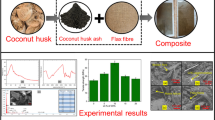Abstract
The aim of the present study was to upgrade the bonding quality and water resistance of medium-density particleboards based on rice husks (RH) as a wood substitute and soybean protein concentrate (SPC) as the binder via chemical modification of SPC. Alkali (A), citric acid (CA) and boric acid (BA) were used to modify proteins and the carbohydrate complex in SPC. The effect of chemical treatment performed on SPC was followed by Fourier transform infrared, differential scanning calorimetry, thermo-gravimetric analysis and initial apparent viscosity measurements. Board properties were evaluated in terms of internal bond (IB) and physical properties. Results revealed that boards bonded with SPC treated with boric acid, exhibited the highest IB and the lowest water absorption and thickness swelling at 2 and 24 h, due to cross-linking reactions with exposed OH-groups in the amorphous region of cellulose of RH. Results demonstrate that boric acid-modified–SPC-bonded boards met the requirements of IB recommended by the US Standard ANSI A208.1-2009 for M1, MS, M2 and M3-grade medium-density particleboards but failed to pass the thickness swelling required. This issue of BSPC-RH boards is compensated for by the benefit of being formaldehyde-free which makes them suitable for indoor applications.




Similar content being viewed by others
References
Nan J, Jun L, Huanyu Z, Jinqiu H (2011) Phenolic resin modified soybean protein adhesive. Adv Mater Research 236–238:3–7
Sun XS, Wool R (2005) Soy protein adhesives in bio-based polymers and composites, 1st edn. Elsevier, London
Kalapathy U, Hettiarachchy NS, Myers D, Rhee KC (1996) Alkali-modified soy proteins: effect of salts and disulfide bond cleavage on adhesion and viscosity. J Am Oil Chem Soc 73:1063–1066
Sun XS, Bian K (1999) Shear strength and water resistance of modified soy protein adhesives. J Am Oil Chem Soc 76:977–980
Cheng E, Sun X, Karr GS (2004) Adhesive properties of modified soybean flour in wheat straw particleboard. Compos Part A Appl S 35:297–302
Mo X, Hu J, Sun XS, Ratto JA (2001) Compression and tensile strength of low-density straw–protein particleboard. Ind Crop Prod 14:1–9
Leiva P, Ciannamea E, Ruseckaite RA, Stefani PM (2007) Medium-density particleboards from rice husks and soybean protein concentrate. J Appl Polym Sci 106:1301–1306
Ciannamea EM, Stefani PM, Ruseckaite RA (2010) Medium-density particleboards from modified rice husks and soybean protein concentrate-based adhesives. Bioresource Technol 101:818–825
Wescott JM, Frihart CR (2004) Competitive soybean flour/phenol–formaldehyde adhesives for oriented strandboard. In: Tichy RJ, Yamada V (eds.) 38th International Wood Composites. Symposium Proceedings, Washington State University, Pullman, pp. 199–206
Zhang Z, Hua Y (2007) Urea-modified soy globulin proteins (7S and 11S): effect of wettability and secondary structure on adhesion. J Am Oil Chem Soc 84:853–857
Nordqvist P, Khabbaz F, Malmstrom E (2010) Comparing bond strength and water resistance of alkali-modified soy protein isolate and wheat gluten adhesives. Int J Adhes Adhes 30:72–79
Lin H, Gunasekaran S (2010) Cow blood adhesive: characterization of physic chemical and adhesion properties. Int J Adhes Adhes 30:139–144
Association, A. S., ASA Soybean Success 2008 Report, http://www.soygrowers.com/publications/ASA2008Report.pdf
Reddy N, Yin L, Yang Y (2009) Alkali-catalyzed low temperature wet crosslinking of plant proteins using carboxylic acids. Biotechnol Prog 25:139–146
Zhang L, Sun XS (2010) Sodium bisulfite-induced changes in the physicochemical, surface and adhesive properties of soy β-conglycinin. J Am Oil Chem Soc 87:583–590
Thevenon M-F, Tondi G, Pizzi A (2009) High performance tannin resin-boron wood preservatives for outdoor end-uses. Eur J Wood Prod 67:89–93
American National Standards Institute (2009) National standard for particleboard ANSI A208.1-2009 A208.1
Ozawa T (1975) Critical investigation of methods for kinetic-analysis of thermoanalytical data. J Therm Anal 4:601–617
American Society for Testing and Materials (1995) Standard methods of evaluating the properties of wood-based fiber and particle panel materials. ASTM D1037-93, ASTM, Philadelphia, pp. 137–155
Chen L, Subirade M (2009) Elaboration and characterization of soy/zein protein microspheres for controlled nutraceutical delivery. Biomacromolecules 10:3327–3334
Kim JT, Netravali A (2010) Mechanical, thermal, and interfacial properties of green composites with ramie fiber and soy resins. J Agric Food Chem 58:5400–5407
Salmoral E, Gonzalez E, Mariscal M, Medina L (2000) Comparison of chickpea and soy protein isolate and whole flour as biodegradable plastics. Ind Crops Prod 11:227–236
Schmidt V, Giacomelli C, Soldi V (2005) Thermal stability of films formed by soy protein isolate-sodium dodecyl sulfate. Polym Degrad stabil 87:25–31
Acknowledgments
The authors wish to express their gratitude to the National Research Council (CONICET) for its financial support (Grant number PIP 1837).
Author information
Authors and Affiliations
Corresponding author
About this article
Cite this article
Ciannamea, E.M., Martucci, J.F., Stefani, P.M. et al. Bonding Quality of Chemically-Modified Soybean Protein Concentrate-Based Adhesives in Particleboards from Rice Husks. J Am Oil Chem Soc 89, 1733–1741 (2012). https://doi.org/10.1007/s11746-012-2058-2
Received:
Revised:
Accepted:
Published:
Issue Date:
DOI: https://doi.org/10.1007/s11746-012-2058-2




